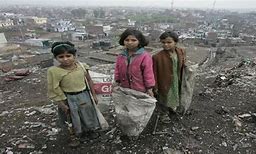|

|
| photo from Save the Children |
Always with us...
This is a story of statistics but it is also a story of poverty, inequality, deprivation and the persistence of these
economic and social evils on a global scale often minimised by being "put into perspective". "The poor are
always with us", said the Victorians: the phrase was both an incentive for charity and an alibi for believing that the
problem of poverty would never go away. Thus a report by the famous social reformer Charles Booth in 1902 observed calmly
that "except among the homeless, who may almost be said to trade on their own wretchedness, there is at present little
extreme poverty [in London]; but 'the poor are always with us'".
The opposite approach has been adopted in reports by global institutions such as the World Bank, by national economic
institutions using the same analysis, and by some economists. Yes, poverty is undoubtedly still a serious problem, they say,
but we should not overlook the enormous progress made in recent decades across the world in bringing down "extreme poverty"
(defined as less than the equivalent of US$1.90 a day per person) to below ten per cent. Sometimes the adjective "extreme"
is omitted, and the criterion is simply described as the "international poverty line", or more crudely still as
"poverty".
No one denies that there has been progress though the numbers are skewed by so much of the improvement having taken
place in China and a few other countries. But we are missing a wider and much darker picture which we can intuitively understand.
How often do news stories about protest or unrest in a particular country observe that poverty, inequality and unemployment
are significant factors? Should we ignore those images of marginal existence in urban slums and desperately poor rural areas?
Is there really room in that "ten per cent" category for all the people so desperately affected?
Seeking more information on poverty across the world, one gets a very different picture. Here are a few statistics culled
in an half an hour's search: Youth unemployment rates in the Middle East and Africa reached 30 percent in 2017. It is 18
percent in well-off Chile. Half the population of Nigeria is living in extreme poverty. In Hong Kong, one in five live below
the same line. In Indonesia, 20 percent are below or close to an even lower "poverty line". Protest in all these
countries is hardly surprising.
Peace is indivisible and should not be seen in isolation from this issue of poverty (and from that of the climate crisis).
Pursuing this as I prepared a new edition of The Glorious Art of Peace (OUP, 2018), I discovered another World Bank definition
of poverty: "moderate poverty" or US $3.10 per person per day. Strangely enough, it was very hard to find unified
statistics for "moderate poverty", nor were they presented alongside those for "extreme poverty". But
by piecing together scattered references, I worked out that at least 20 percent of the world's population live in moderate
or extreme poverty -- a rather different picture.
As it turns out, my estimate was still too low. The World Bank has finally begun to catch up with reality and last
year produced a new set of figures. The title of their report (which gained very little attention) is a revealing one: "Piecing
Together the Poverty Puzzle". In it the Bank acknowledges both that people who are poor in medium or rich income countries
find life more expensive, and that poverty has to be seen in a social context. And it unveils two new levels of poverty according
to which "a quarter of the world [in 2015] was living on less than US$3.20 per person per day, and close to half the
world was living on less than US$5.50 per person per day."
We should challenge any attempt now to set a low threshold for poverty and then claim huge success for poverty alleviation,
or to ignore the geographical unevenness of improvement and the variable factors admitted by the World Bank. And we should
challenge attempts to portray "economic migrants" as having made a lifestyle choice: they are usually fleeing desperate
poverty. Our choice is whether to spend money on making weapons or on helping them.
|

